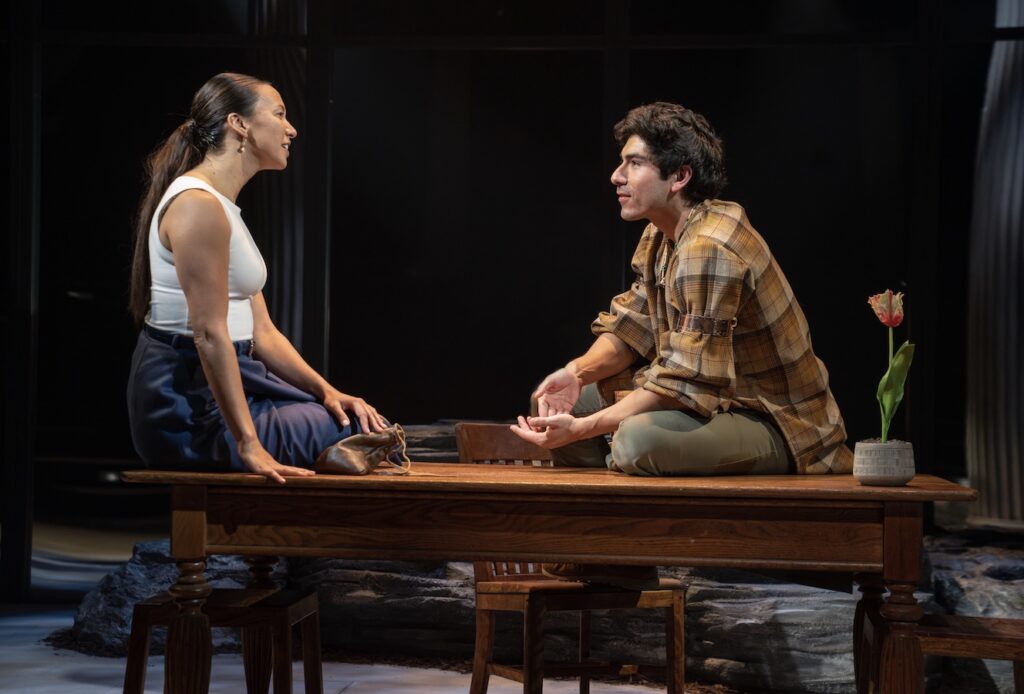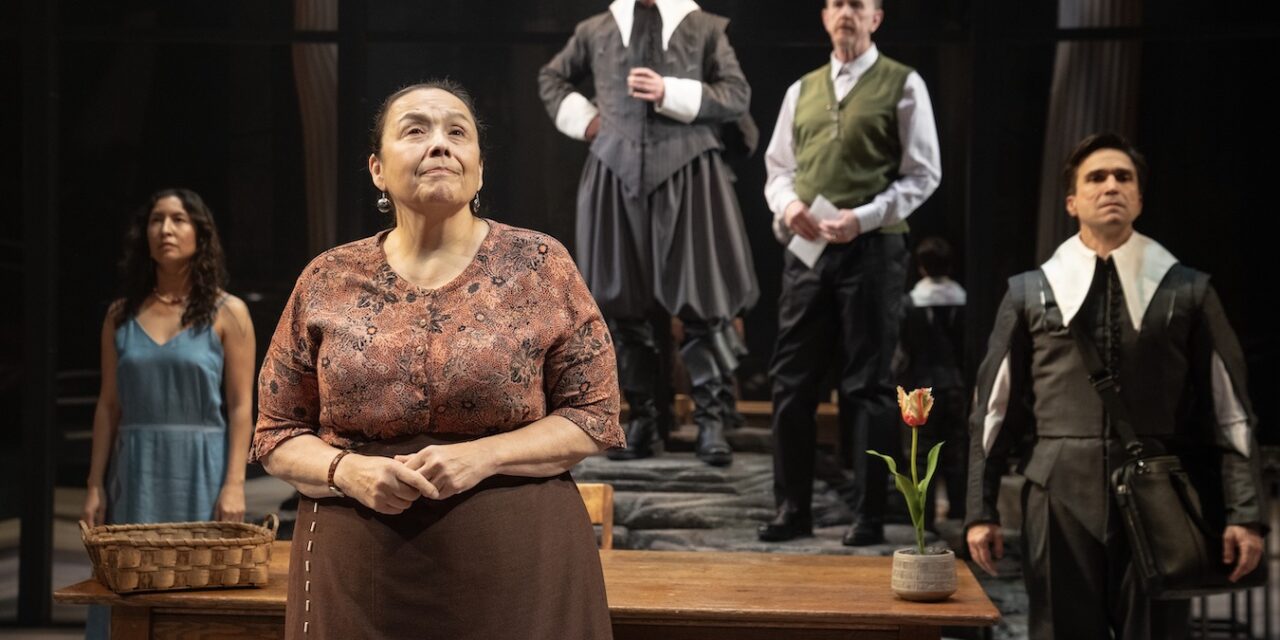Theater Review by Samuel L. Leiter . . . .
For the past several years visitors to a number of New York theater lobbies will likely have noticed a respectful sign posted on a wall acknowledging that the land on which the theater stands was originally part of the homeland of the Lenape people. A version of such acknowledgment is often printed in theater programs, as, for example, that for the Public Theater’s current production of Mary Kathryn Nagle’s Manahatta, whose world premiere was at the Oregon Shakespeare Festival. It declares that the Public “stands in honor of the First People and our ancestors,” and pays “respect to the many diverse indigenous people still connected to the land.” This is followed by a note of gratitude to the Public’s “partners at the Lenape Center.”
Despite such recognition of the Lenape, or, for that matter, any other Native American peoples, the number of significant plays reflecting their concerns and written by people of Indigenous heritage is tiny. Recently, however, the New York stage has turned its attention to two such works: one being Nagle’s Manahatta, a serious drama; the other Larissa Fasthorse’s The Thanksgiving Play, a satirical comedy that made the move from Off to on Broadway. Each playwright has a Native heritage, Nagle’s being Cherokee. She, it might be noted, is also an attorney and an expert on tribal sovereignty.

Nagle’s drama, much the less successful of the two, is a moderately interesting, if clumsy, attempt to express historical Lenape-related issues by integrating narratives about them set in 1626 and 2008. Much of the action in both eras occurs in Manhattan’s Wall Street area. In the historical scenes, we see the Lenape and the Dutch interacting on the island of what was then called Manahatta, when New York was still New Amsterdam. In the contemporary scenes, we observe an ambitious, well-educated Lenape woman dealing with her domineering white employers at Lehman Brothers—the now-defunct investment firm—during the 2008 financial crisis.
All the actors in the seven-member cast play two roles, one in the past and one in the present. Marcelo Martínez García’s neutral set, dominated by a wooden table/desk, does nothing to differentiate the periods, so the periods are, for a time, defined by costuming (credit: Lux Haac). Gradually, the scenes shift more rapidly between one time and the other, heading for a merger culminating in 2008. Jeanette Oi-Suk Yew’s lighting helps greatly in effecting the transitions and giving life to the bland setting.
In the historical scenes, set in 1626, the Natives—primarily a young woman, Le-le-wa’-you (Elizabeth Frances), and a man, Se-ket-tu-may-qua (Enrico Nassi)—are seen as peaceful villagers, acquiring furs, preparing the pelts for use, and trading them to the cunning Dutch, who profit from the Natives’ innocence of the white man’s ways. This culminates in Peter Minuet (Jeffrey King) bamboozling the Lenape—who don’t comprehend how they’re being manipulated—into signing away their assumed ownership of Manahatta for what Nagle imagines the sum of “six knives, three axes, twelve kettles, and six guns.” This is her fanciful way of memorializing the famous, but mythical, deal according to which the Dutch obtained New York by financial, not military conquest, for a reputed $24, under circumstances for which there is no contemporaneous documentation.


An excellent discussion of the myth is in Edwin G. Burroughs and Mike Wallace’s humongous, Pulitzer Prize-winning Gotham: A History of New York City to 1898, pp. xiv-xvi. Burroughs and Wallace emphasize the myth’s importance in establishing that “New York would become a city of deal makers, a city of commerce.” Nagle uses this notion to demonstrate not only how the transaction planted the capitalistic seed of greed from which would sprout the speculative Wall Street subprime mortgage debacle of 2008, but also instigate the gradual erasure of the Lenape culture and language, as well as the Lenape people’s diaspora to faraway states.
In the contemporary scenes, we view the Lenape woman, Jane Snake (Elizabeth Frances), a Stanford graduate, being hired as a banker by Lehman Brothers after a cruelly insensitive interview by a banker named Joe (Joe Tapper). Jane, the only Native American in the firm, is determined to do well, but her ultra-sensitivity to perceived slights to her heritage makes her rather humorless; Joe’s innocuous comment about her sellers having “gone off the reservation” is enough to put her on the warpath (a phrase for which she’d slap me down). Then—after initially being fired by an overweening higher-up named Dick (Jeffrey King, ramping up the haughtiness in a role presumably based on Lehman CEO Richard Fuld)—she succeeds by being even more ruthlessly aggressive than her bosses. Her job, however, rejoins her to the Manahatta that’s so important to her tribal history.
Meanwhile, in rural Oklahoma, where many of the Lenape now reside, Jane’s mother, Bobbie Snake (Sheila Tousey), who lives with her other daughter, Debra (Rainbow Dickerson), is in danger of losing her home. She can’t pay her mortgage, you see, a happenstance connected to Wall Street’s imminent comeuppance, and included here to mirror Minuet’s devious acquisition of Manahatta centuries earlier. Once again, the Native Americans are swindled by the capitalists, who seek to erase even where the Natives live, “home” being a running theme.


For one thing, though, the idea that the subprime scandal, which affected millions of people across racial and economic lines, should, like the acquisition of Manahatta, be viewed as targeted toward Native Americans, is a glaringly false equivalency. For another, Nagle’s creation of a situation in which poor old Bobbie is about to lose her home because she can’t pay the mortgage could not be more hackneyed; as anyone familiar with 19th-century melodrama knows, it’s a retread of the old “I can’t pay the rent” trope, with a savior arriving just in the nick of time. And, because Nagle wants to glorify Bobbie as a noble representative of her people, she composes a hokey treatment of the biting-off-one ’s-nose variety that’s more inspiring in the abstract than in reality.
Much consideration has been given to the authenticity of the Native elements (including casting Native actors for those roles), with assistance from expert consultants. The Lenape language gets some attention in scenes where the problems of communication between English and Lenape speakers are portrayed in a manner reminiscent of the conflict between Irish and English in Brian Friel’s Translations, currently playing at Irish Rep.
During such linguistic discourse, the heroic, bilingual Se-ket-tu-may-qua takes a vital role. Nevertheless, the historical man of this name was actually a highly regarded 19th-century figure, Nagle deliberately having transferred him to the 17th century. In the script, Nagle insists that this is a work of fiction, not of historical accuracy and that she has taken the dramatic liberty of moving him several centuries back in time.


Under the direction of Laurie Woolery, who staged a workshop version at the Public in 2014, this smoothly staged, three-quarters-round, hour and 40-minute production can’t prevent several of the characters—both Natives and whites—from being more pasteboard than human, their existence based mainly on the need to illustrate Nagle’s thesis. And, while the time transitions are required to fulfill Nagle’s premise, the need to bring them together sets up a too obviously contrived situation when, as noted above, Jane, her company in shambles, happens to show up at Bobbie’s just at the climax of her mortgage dilemma, from which Jane has conveniently been kept ignorant.
Most noteworthy of the performances are those of Elizabeth Frances and Sheila Tousey. Frances makes a nice transition from the gentle, if wooden, Le-le-wa’-you of the 1620s to Jane, the convincingly determined, glass-ceiling breaker. Tousey’s Bobbie rings consistently true, bringing a refreshingly understated honesty to every line, expression, and gesture. She also gets the biggest laugh with a corny old pun-joke about tea, which I shall not repeat.
A curious thing: like countless other American cities, NYC has streets and neighborhoods derived from Lenape words, like Gowanus and Canarsie, but, aside from a playground in Sheepshead Bay, I don’t see anywhere in the city that uses Lenape in its name. With so many of our fair Gotham’s thoroughfares regularly changing their names, usually to that of some celebrity, isn’t it about time we had a Lenape Lane, a Lenape Boulevard, or a Lenape Street?
Manahatta. Through December 23 at The Public Theater’s Anspacher Theater (425 Lafayette Street at Astor Place). www.publictheater.org
Photos: Joan Marcus
Cover photo caption: Rainbow Dickerson, Sheila Tousey, Jeffrey King, David Kelly and Joe Tapper


















